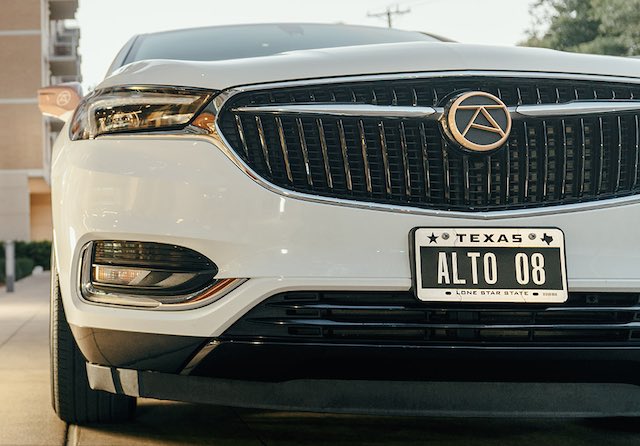Alto is a rideshare company that was founded in Dallas and so far is also operating in Houston, Los Angeles, Miami, San Francisco, and Washington. The company differs from traditional rideshare operations like Uber and Lyft in that it owns all of its automobiles and all of its drivers are employees, not contractors. This is supposed to make it more attractive to passengers, especially women, who may be squeamish about riding in a stranger’s car.
Photo courtesy of Alto.
Alto claims that its rides are “elevated” above other ridesharers. Its fleet currently seems to consist of Buick Enclaves, a cross-over with three rows of seating. It has replaced the Buick logo on the grill with its own and added its logo to other parts of the vehicles as well. However, it plans to transition soon to all-electric vehicles.
While I’m always intrigued by new business models, I can’t help but feel this one is going in the wrong direction. The intercity bus market went from Greyhound, which owned its own buses, stations, and maintenance facilities, to Megabus, which owned buses and maintenance facilities but no stations, to Flx, which didn’t even own its own buses and maintenance facilities. In other words, the newer models shed costs and spread the risk to more operators.
Uber and Lyft disrupted the taxi market because they replace call centers and human taxi dispatchers with smart phones and automated dispatch. In 2019, some predicted that Uber would never be profitable, but it had its first profitable quarter in 2021 and today both Uber and Lyft claim to be making a profit.
Uber and Lyft have been criticized for treating drivers as contractors and not employees, yet most taxi companies do the same. Uber and Lyft may make less effort than taxi companies to ensure uniformity of service, as not all drivers own the same make and model of vehicles, but it has been my experience, at least, that vehicles are clean, in good condition, and relatively new. The drivers, not Uber or Lyft, take the risk that the vehicles they own won’t earn enough to pay for themselves, but from the customer’s viewpoint that leads to more competition and faster service.
Alto’s model absorbs all of the risk that Uber and Lyft spread among their drivers. That could be quite expensive. Buick Enclaves list for about $45,000, and while I’m sure Alto gets quantity discounts, the $60 million it had raised by mid-2021 is hardly enough to buy 3,000 Enclaves, much less replace them all with electric vehicles by the end of this year, which was Alto’s goal.
Given the limited number of vehicles in its fleet, Alto won’t promise 5-minute wait times like Uber and Lyft can often do. While people can pre-schedule a car, spontaneous Alto customers can expect to wait 10 to 15 minutes. Also, Alto doesn’t operate 24 hours a day; instead, depending on the city, it is shut down for three to five hours each night. Furthermore, while Uber and Lyft are available in hundreds of U.S. cities, Alto is currently limited to just six, which means frequent travelers will keep the Uber and/or Lyft apps even after they’ve tried Alto. Another disadvantage is that all of Alto’s fleet of cars have to be big enough to carry the largest party that might want to use them (i.e., six passengers), while Uber and Lyft can tailor the size of the vehicles they send to the number of people in each party.
Alto hopes to overcome the disadvantages of its model with a new twist: a membership system. For $12.95 a month or $119 a year (with a $99 introductory rate), members would get discounts for their rides, priority booking, and other perks. This is the Costco model: Costco prices its goods so that they just cover their costs, while its profits come from the membership fees people pay to enjoy those low prices. In Alto’s case, once someone has paid a membership, they will prefer Alto, where and when it is available, over other ridesharing companies until their membership runs out.
Uber and AirBnB were able to rapidly grow because they were essentially software companies, which means the marginal cost of growth was effectively zero. While AirBnB has become highly profitable, anyone who tried to compete by buying thousands of homes and renting them out would likely fail. When Zillow, for example, tried to put its real estate expertise to work by getting into the home-flipping business, the result was a financial disaster.
The sharing models are also more resilient: when COVID struck, many people who drove Uber/Lyft cars or rented rooms via AirBnB saw their income decline, but the companies themselves didn’t have to pay the overhead of unused vehicles and underemployed drivers. Alto will have a more difficult time surviving the next economic contraction.
I’m not going to predict that Alto will absolutely fail, but I’m dubious about whether a membership system combined with the slightly elevated security of driver-employees over driver-contractors will be enough for Alto to compete successfully against Uber and Lyft. This seems more likely to end like Zillow’s home-flipping operation than with a profitable bottom line.









Never underestimate membership system.
– Costco
– certain credit cards
– clubs
– theme parks
– resorts
The single biggest thing for Uber for disrupting the market was the app showing where the cars are + letting you know when they’ll arrive. Hands down that’s the magic that without, we never would’ve heard from them.
BTW – Uber and Lyft offer memberships, too.
“The company differs from traditional rideshare operations like Uber and Lyft in that it owns all of its automobiles and all of its drivers are employees, not contractors. ”
How is that different from an old-fashioned cab company?